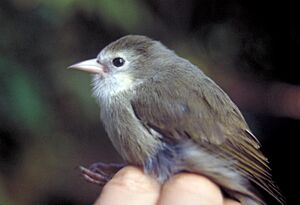ʻAkikiki facts for kids
Quick facts for kids ʻAkikiki |
|
|---|---|
 |
|
| Conservation status | |
| Scientific classification | |
| Genus: |
Oreomystis
|
| Species: |
bairdi
|
 |
|
The ʻakikiki (Oreomystis bairdi), also known as the Kauaʻi creeper, is a very rare bird found only on the island of Kauaʻi in Hawaiʻi. It is a type of Hawaiian honeycreeper, a group of birds unique to Hawaiʻi. This special bird is the only species in its group, called Oreomystis.
The ʻakikiki is one of the most endangered birds in Hawaiʻi. In 2018, there were about 454 of them in the wild. By 2021, this number dropped to only 45. Sadly, by July 2023, experts believed there were only 5 wild ʻakikiki left. Scientists predict this bird might disappear from the wild very soon.
Contents
What the ʻAkikiki Looks Like
The ʻakikiki is a small bird, about 13 centimeters (5 inches) long. It weighs between 12 and 17 grams, which is about as much as a few quarters. Its feathers are gray on its back and white underneath.
Both male and female ʻakikiki look the same. Young birds have clear white rings around their eyes. As they grow older, some adults might keep a light eyebrow. Their legs and beaks are pink. The ʻakikiki has a short tail, which makes it look a bit chunky compared to other birds on Kauaʻi.
How the ʻAkikiki Communicates
The adult ʻakikiki makes a short weet or whit sound to talk to other birds. Sometimes, they double this sound. Their call can sound similar to another bird called the ʻanianiau, which they sometimes flock with.
During the breeding season, the ʻakikiki sings a special song. It is a trilling sound that goes lower in pitch. Young birds make a stuttering series of chits. Female birds use a similar call when they want the male to bring them food.
Where the ʻAkikiki Lives
Today, the ʻakikiki can only be found in the highest parts of the native rainforests on Kauaʻi. These areas are mainly in Kokeʻe State Park and the Alakaʻi Wilderness Preserve.
Old records show that these birds once lived closer to the sea. This means they probably used to live in more types of places, including drier forests.
What the ʻAkikiki Eats
The ʻakikiki is often compared to nuthatches, a type of bird found in North America. This is because it finds its food by hopping along the trunks and branches of trees. It picks off small bugs and insects, which are called arthropods.
ʻAkikiki often hunt for food in pairs or family groups. They also sometimes join mixed groups with other bird species.
ʻAkikiki Reproduction and Life Cycle
Not many ʻakikiki nests have been found, so we don't know everything about their breeding habits. They usually build their nests from March to June. Both the male and female birds help build the nest using moss and lichen. They place these nests several meters high in the tops of ʻohiʻa trees.
Only the female bird sits on the eggs to keep them warm. However, both parents work together to feed the baby birds once they hatch. Young ʻakikiki stay with their parents for a long time. Because of this, a pair usually only raises one group of babies each breeding season.
In 2018, the first ʻakikiki was successfully hatched and raised in a special program at the San Diego Zoo. This was a big step for their conservation.
Why the ʻAkikiki is in Danger
The ʻakikiki's home has shrunk a lot. This is due to deforestation, which means forests are cut down. Also, invasive species, which are plants and animals brought to Hawaiʻi by people, have damaged their habitat.
One major threat is Avian malaria, a disease carried by mosquitoes. Most Hawaiian honeycreepers, including the ʻakikiki, do not have strong protection against this illness. This disease affects birds living below about 1000 meters (3,280 feet) in elevation. This forces the ʻakikiki to live only in higher, cooler areas.
Introduced rats are also a big problem. They are believed to eat many ʻakikiki eggs and baby birds in their nests. Other non-native birds, like the Japanese white-eye, might also compete with the ʻakikiki for food and living space.
Protecting the ʻAkikiki
The ʻakikiki has been listed as critically endangered by the IUCN Red List since 2000. This means it is at an extremely high risk of disappearing forever. It was also listed as an endangered species under the Endangered Species Act in 2010.
Because so little is known about this bird, early efforts focused on figuring out how many birds were left and learning about their basic life. Now, plans include breeding them in captivity, releasing them back into the wild, and restoring their natural home.
Between 2018 and 2021, the ʻakikiki population dropped very quickly in one of its main areas, Halehaha. It went from 70 birds to only 5. This big decline is thought to be because climate change is making it warmer, allowing mosquitoes that carry avian malaria to move into higher areas where the birds live.
Scientists predict that if the decline continues, the ʻakikiki could become extinct in the wild by 2023. There are about 41 ʻakikiki living in captivity, but it has been hard to get them to have many babies. The plan is to keep many ʻakikiki safe in captivity. At the same time, scientists hope to control mosquitoes using a special bacteria called Wolbachia, possibly starting in 2024. After that, the birds could be released back into their improved habitat.
In 2015, a high school teacher from India suggested that a celestial body be named Akikiki. After thinking about it, asteroid number 7613 was officially named [[7613 ʻAkikiki]].
Images for kids



